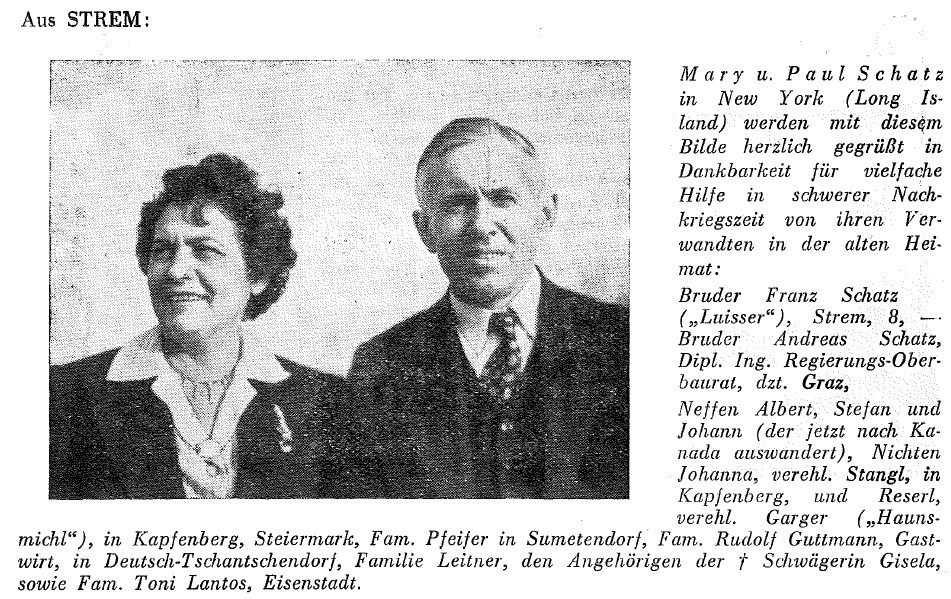|
The
|
|
THE BURGENLAND BUNCH NEWS - No. 220 April 30, 2012, © 2012 by The Burgenland Bunch All rights reserved. Permission to copy excerpts granted if credit is provided. Editor: Thomas Steichen Our 16th Year. The Burgenland Bunch Newsletter is issued monthly online. It was founded by Gerald Berghold (who retired Summer 2008 and died in August 2008). |
|
Current Status Of The BB: * Members: 2052 * Surname Entries: 6956 * Query Board Entries: 4957 * Staff Members: 18 |
|
This newsletter concerns: 1) THE PRESIDENT'S CORNER 2) UNTERWART / ALSÓŐR (by Laslo "Laci" Szabo) 3) 2012 BURGENLAND GOVERNMENT DELEGATION VISIT (Part 2) 4) ANOTHER LINK REMOVED... 5) "DIE AMERIKA-WANDERUNG DER BURGENLÄNDER" THIRD EDITION 6) ROBERT LOERZEL'S MISCHENDORF GENEALOGY WEBSITE 7) LDS FILMS SECTION UPDATE: A FOLLOW-UP 8) HISTORICAL BB NEWSLETTER ARTICLES: ELLIS ISLAND BURGENLAND TRANSLATIONS 9) ETHNIC EVENTS (courtesy of Bob Strauch, Kay Weber & Margaret Kaiser) 10) BURGENLAND EMIGRANT OBITUARIES (courtesy of Bob Strauch) |
|
1) THE PRESIDENT'S CORNER (by Tom Steichen)  Concerning
this newsletter, we start off with a contribution from Vienna resident Laslo Szabo, who
tells us about his native village, Unterwart. Unterwart / Alsóőr is unique in being the
only majority-ethnic-Hungarian village in all of Austria. Its Hungarian name, Alsóőr,
explains much about its history (along with the history of companion villages Oberwart / Felsőőr
and Siget in der Wart / Őrisziget), but I'll let Laslo tell you about that. Concerning
this newsletter, we start off with a contribution from Vienna resident Laslo Szabo, who
tells us about his native village, Unterwart. Unterwart / Alsóőr is unique in being the
only majority-ethnic-Hungarian village in all of Austria. Its Hungarian name, Alsóőr,
explains much about its history (along with the history of companion villages Oberwart / Felsőőr
and Siget in der Wart / Őrisziget), but I'll let Laslo tell you about that.We follow it with the second part of my report on the 2012 Delegation Visit to North America; specifically the details on the BB's involvement with the delegation in the Lehigh Valley. Next I provide a very personal report—about the Death, and Life, of my Mother. She was my tie to Burgenland and my partner in genealogy; and she will be missed. We follow that with a short section I wrote for inclusion in the Third Edition of Dr. Dujmovits Book on Burgenland Emigration. Next, we tell you about Robert Loerzel's Mischendorf Genealogy Website and give a follow-up to last month's article on the BB LDS Pages. Finally, we provide our standard sections: Historical Newsletter Articles, and the Ethnic Events and Emigrant Obituaries sections. It was 20 months ago, in August 2010, that I announced the retirement of Hannes Graf from the BB.  Just
last month, I reported that he had suffered a heart attack in early March and was setting
aside his Internet/Burgenland activities to concentrate on getting better. Recently he
reported such improvement that he is now able to take daily 3-5 km slow walks as part of his
rehabilitation. He also noted the retirement of Heidi Herman from the
Members/Surnames/Villages editor role and, being the Burgenland trooper that he is, offered to
take on part of it. So, please welcome our new (and old) Members Editor,
Hannes Graf! Just
last month, I reported that he had suffered a heart attack in early March and was setting
aside his Internet/Burgenland activities to concentrate on getting better. Recently he
reported such improvement that he is now able to take daily 3-5 km slow walks as part of his
rehabilitation. He also noted the retirement of Heidi Herman from the
Members/Surnames/Villages editor role and, being the Burgenland trooper that he is, offered to
take on part of it. So, please welcome our new (and old) Members Editor,
Hannes Graf! Hannes will start slowly, to avoid over-doing, but later may take on Surnames and Villages, assuming his comfort level allows. For now, doing this keeps him in the Burgenland genealogy world without the necessity for the research and on-site visits that are required to publish worthwhile articles. With his prior experience, this is, as he says, just "time in front of a computer" ...and that he can do. Welcome back, Hannes! Richard Potetz wrote to comment on the last newsletter... one thing he said was that...
While I would not be surprised if Richard learns that this family story exaggerates the
truth a bit, emigration was halted by WW-I and military-age men were the first to have their
travel restricted. Thanks for the note, Richard.
This any relationship to you?"
|
|
2) UNTERWART / ALSÓŐR (by Laslo "Laci" Szabo) 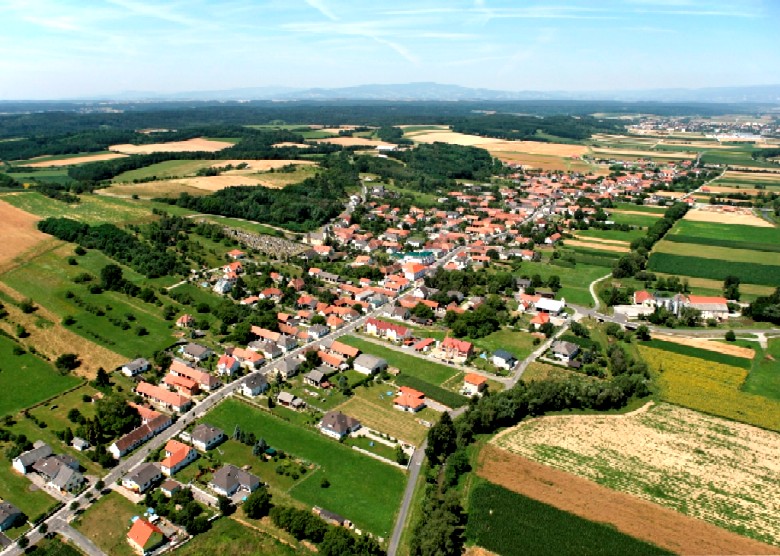 Unterwart (Hungarian: Alsóőr; Croatian: Dolnja Borta), in the district of Oberwart (Hungarian: Felsőőri Járás), lies on the banks of the Pinka river and is the only settlement in Austria with an ethnic Hungarian majority. It is part of the Upper Őrség micro-region, a small Hungarian-language island that includes Oberwart and Siget in der Wart (Őrisziget). 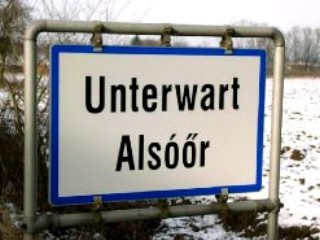
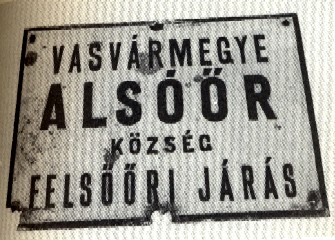 Street Signs: Today and During the Monarchy Population: Around 1900, it had about 1800 inhabitants (the peak in its history). Poverty-driven emigration left Unterwart with a population of about 700 in 2010. In the first part of the 20th century, emigration was mainly to the US (St. Louis, Chicago); today their descendants are scattered over all the US, Canada and Australia. After WW-II, emigration was to nearby large cities, such as Vienna and Graz, where jobs were offered. History Alsóőr / Unterwart was established together with Felsőőr / Oberwart in the early Middle Ages. Before the Hungarians took possession of the region in 900, ore mining and iron processing is known to have taken place in Unterwart. As the name of the villages indicates, they were part of the border-zone of the Kingdom of Hungary (gyepű = border guarding system). The population was made up of Hungarian frontier guards (őr), probably related to the Székelys of Transylvania. The guards constituted a free, privileged community. Alsóőr belonged to the old Hungarian county of Vas until 1921. In 1327, King Charles I of Hungary confirmed the rights of the villagers and ranked them among the nobles. Although later they lost their military significance, the noble őrs kept their privileges and defended them resolutely against the intentions of big landowners. The Hungarian Parliament confirmed their rights several times (1478, 1498, 1547, 1611). The society of Alsóőr in the 18-19th centuries was made up of two classes, the nobles (nobilis) and the non-nobles (agilis). The lands of the village were the property of Community of the Nobles until 1859, when they were distributed to the nobilis under private ownership. The agilis only used some parts of it or made their living from handicrafts, like boot-making, book-binding, lathe operator, hatter, tanner, blacksmith, etc. In the middle of the 19th century, 47 different crafts were practiced in the village, and the tailors even established their own guild. As the role and importance of the Guards diminished, agriculture became the main occupation and basis for making a living, including cattle trade, horse breeding and 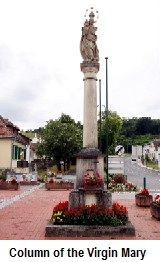 viniculture
(until a grape disease brought it to end around 1850). viniculture
(until a grape disease brought it to end around 1850).In the Age of Reformation, the people of Alsóőr converted to Lutheranism but, contrary to the neighboring Felsőőr, later they returned to the Roman Catholic faith. The village became an independent parish in 1808. The village became part of the Republic of Austria after the Treaty of Trianon in 1921, although the Hungarians of the Felső-Őrség opposed the change. Unterwart remained a poor agricultural community well until the 1970s. After World War II, Unterwart/Alsóőr underwent a thorough modernization and industrialization, with the building of roads, civic buildings, sewage canals and the regulation of the Pinka. An industrial zone has led to the settlement of several enterprises, offering jobs to the local people. A tribute to our times: none of the earlier 47 crafts are practiced anymore. In the recent past, a new club house, fitness centre, doctor's office and two-story houses were built, giving a modern appearance to the village. A small Gypsy / Roma settlement exists at the outskirts of the village. In 1971, the neighboring small German village of Eisenzicken was merged into Unterwart. Today, the local primary school (Népiskola, Volksschule) is bilingual (German-Hungarian). The village school was first mentioned in 1697. The new school building with a kindergarten was built in 1989. 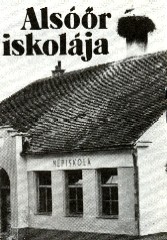
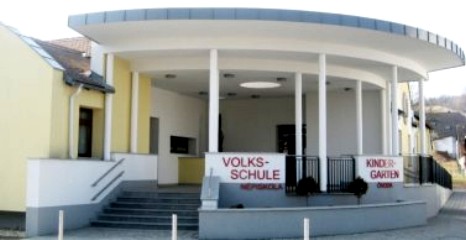 The Old and New Schools Since the beginning of the 20th century, several cultural and economic associations have been established. The Hungarian village library, with more than 5000 books, was established in 1975 by Reverend Galambos Ferenc Iréneusz, a teacher, parish priest, librarian and editor. He brought the old folk traditions back to life. Today UMIZ (Hungarian Media and Info Center) is caretaker of the library and supports and assists activities to preserve the Hungarian cultural heritage. The question today: how can the heritage of a millennium be preserved in a world of high mobility, migration and globalization? Sights Roman Catholic Church of Saint Catherine of Alexandria: In 1697, the village of Alsóőr had a little church built of wood with a painted ceiling. In 1769, the Community of Nobles erected the present-day stone church with a tower, replacing the old wooden church. It was enlarged in 1833. The main altar is decorated with wooden statues of St. Stephen, King of Hungary, and his son, St. Emericus. The baroque Column of the Virgin Mary (see picture above in the History section) was erected in front of the church in the first half of the 18th century. 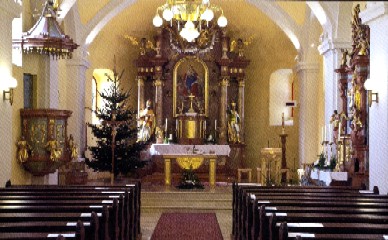
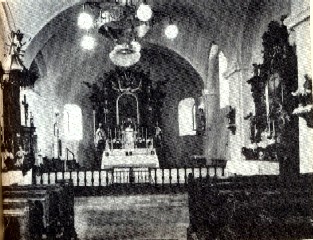 Church of Saint Catherine of Alexandria: Interior View Today and Previously Village Museum (Falumúzeum, Heimathaus): The village museum was established in 1973. Two historic houses, complete with furniture, give an interesting insight into the life of the peasants of Alsóőr in the 19-20th centuries. 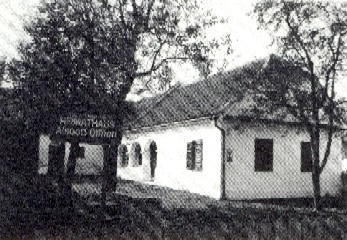
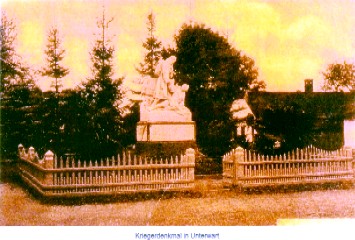 Village Museum of Local History and The War Memorial (WW-I & WW-II) Peasant Houses: Below are typical examples of the architecture of the Felső-Őrség, with varied porches and stuccoed gables. 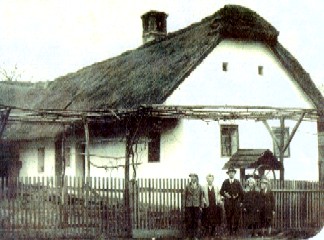
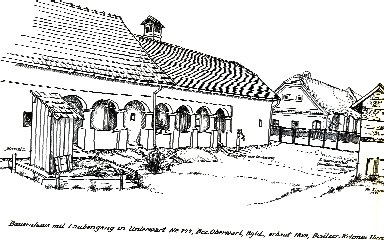 Coat-of-Arms: The coat-of-arms of Unterwart/Alsóőr refers to the origin of the two villages as Hungarian border-guard communities. The earliest arms depict an old frontier guard (őr) on a silver shield wearing a red uniform and a blue jacket, holding up a sword in his raised right hand. The Nobility also has an official seal with Latin words “Álso Eoriensis Nobilitas”) meaning "Nobility of Unterwart [Also Ör]"). 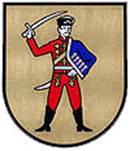
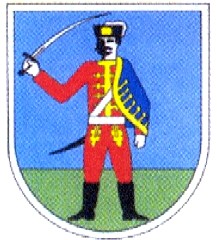
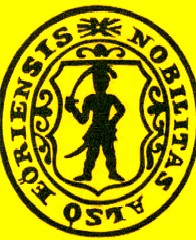 Some Impressions of the Village: 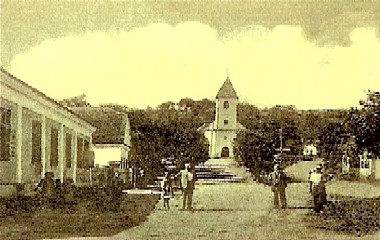
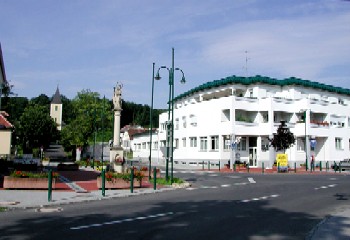 The Main Square around 1930 and Today 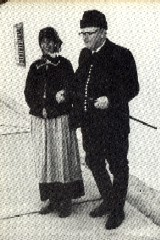
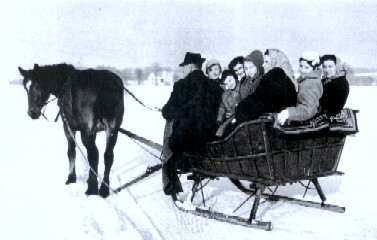 Festive Dress in Winter and a Sunday Afternoon in Previous Days 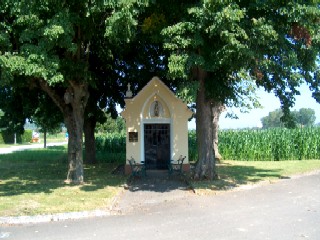
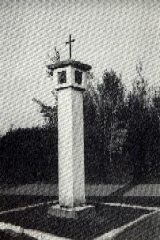
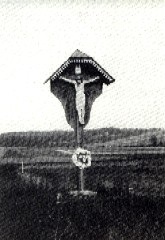 The Chapel of St. Florian and two Wayside Crosses 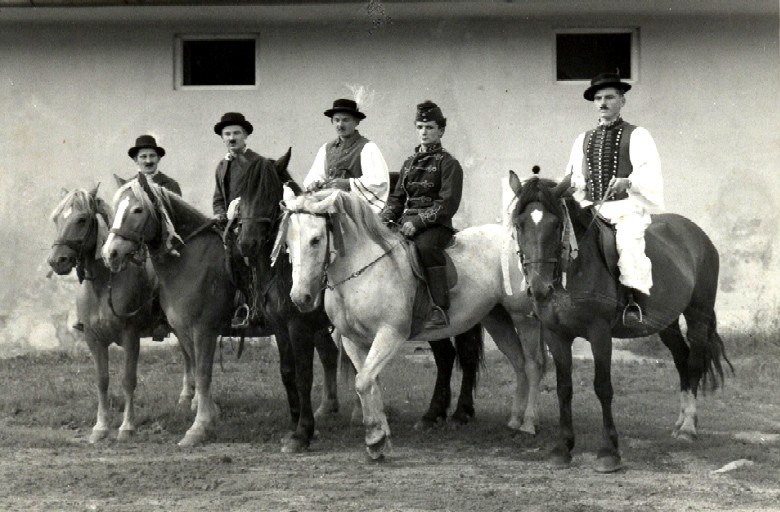 Keeping Old Traditions Alive… |
|
3) 2012 BURGENLAND GOVERNMENT DELEGATION VISIT (Part 2) Last month, I gave an overview of the recent Burgenland Government delegation visit to Burgenland-emigrant enclaves in North America. The delegation visited Toronto, the Lehigh Valley of Pennsylvania and New York City from March 18th to the 26th. The visit was led by Burgenland Governor Hans Niessl and he was accompanied by members of his cabinet and government support staff, Walter Dujmovits and Klaus Gerger from the BG, and an ORF TV team and a reporter from Kronen Zeitung, the largest Austrian newspaper. This month, I will provide more details of those events in the Lehigh Valley that directly involved the BB. 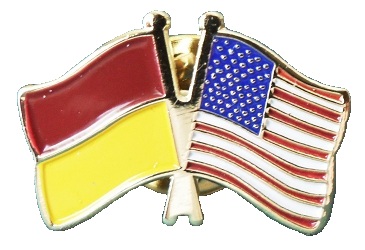 The
first event was a luncheon on Wednesday that was hosted by the delegation, and where BB
representatives and guests discussed items of mutual interest with the delegation. In
attendance from the BB staff were Frank Paukowits, Fritz Königshofer, Margaret Kaiser, John
Lavendoski, Bob Strauch, myself and Klaus Gerger, who also was part of the government
delegation. In addition, we were joined by Ed and Frank Tantsits, who have made important
contributions to the BB, and our personal guests. All were given a lapel pin consisting of
joined US and Burgenland flags that indicated the special fellowship that exists. The
first event was a luncheon on Wednesday that was hosted by the delegation, and where BB
representatives and guests discussed items of mutual interest with the delegation. In
attendance from the BB staff were Frank Paukowits, Fritz Königshofer, Margaret Kaiser, John
Lavendoski, Bob Strauch, myself and Klaus Gerger, who also was part of the government
delegation. In addition, we were joined by Ed and Frank Tantsits, who have made important
contributions to the BB, and our personal guests. All were given a lapel pin consisting of
joined US and Burgenland flags that indicated the special fellowship that exists.Landeshauptmann Hans Niessl, with Klaus Gerger translating, welcomed all of us and spoke a bit about Burgenland. In a theme he repeated more formally in later events, he told us about how much Burgenland has transformed itself relative to the time our forefathers were forced to emigrate to survive. Over the last 50 years, life expectancy for residents has risen dramatically, from 65 to 78 years for men and from 73 to 84 years for women. Now, jobs in internet and "green" technology dominate, the wine industry has blossomed and the Land has become a tourist destination, with overnight stays tripling from one million to three million overnight stays per year during the last 40 years. Governor Niessl later shared with me a 75-page glossy report on their 2011 Regional Development Program (Landesentwicklungsprogramm Burgenland - LEP 2011) that details the principles and objectives for development over the next 10 years (the EU funds I discussed in past newsletters provides financial support for this plan). In turn, I thanked him and the delegation for honoring the BB by their invitation to lunch (again with Klaus translating) and shared a German translation (thanks to Fritz) of the note I had published in February about the continued growth of the BB.  The
next event, Wednesday evening, was a gathering at the Northampton Liederkranz, kicked off by a
welcome from Northampton mayor Thomas Reenock, addresses by Governor Niessl and Landesrätin
Michaela Resetar, and the unveiling of the third edition of Dr. Walter Dujmovits' book, Die
Amerika-Wanderung der Burgenländer. Klaus Gerger has been extensively involved in
designing and publishing the book. However, exact details on availability and pricing are not
yet available ...but I will publish that information once it is known. Of special importance
to many is that Bob Strauch is diligently working on translating the book into English, though
enough work remains so Bob and Walter are not yet committing to a release date for the English
version. Again, details will be published when available. The
next event, Wednesday evening, was a gathering at the Northampton Liederkranz, kicked off by a
welcome from Northampton mayor Thomas Reenock, addresses by Governor Niessl and Landesrätin
Michaela Resetar, and the unveiling of the third edition of Dr. Walter Dujmovits' book, Die
Amerika-Wanderung der Burgenländer. Klaus Gerger has been extensively involved in
designing and publishing the book. However, exact details on availability and pricing are not
yet available ...but I will publish that information once it is known. Of special importance
to many is that Bob Strauch is diligently working on translating the book into English, though
enough work remains so Bob and Walter are not yet committing to a release date for the English
version. Again, details will be published when available. Of
special significance to the BB on Wednesday night was that the Burgenland government chose to
honor four members of the BB staff for their commitment and contributions to Burgenland
through their work with the BB. With Governor Niessl and Dr. Dujmovits Of
special significance to the BB on Wednesday night was that the Burgenland government chose to
honor four members of the BB staff for their commitment and contributions to Burgenland
through their work with the BB. With Governor Niessl and Dr. Dujmovits
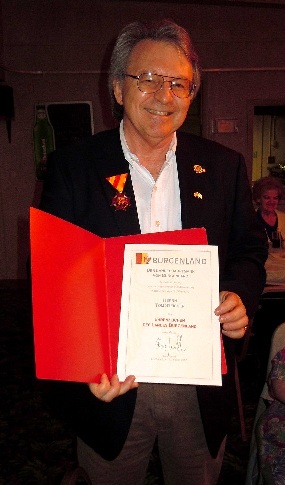 handling
the ceremony, Margaret Kaiser received the Silberne Medaille des Landes
Burgenland (Silver Medal of the State of Burgenland), Frank Paukowits and Fritz
Königshofer received the Goldene Medaille des Landes Burgenland (Golden Medal), and I
was awarded the Ehrenzeichen des Landes Burgenland (Badge of Honor). handling
the ceremony, Margaret Kaiser received the Silberne Medaille des Landes
Burgenland (Silver Medal of the State of Burgenland), Frank Paukowits and Fritz
Königshofer received the Goldene Medaille des Landes Burgenland (Golden Medal), and I
was awarded the Ehrenzeichen des Landes Burgenland (Badge of Honor). By statute, the Burgenland Honor Medals are "...awarded to 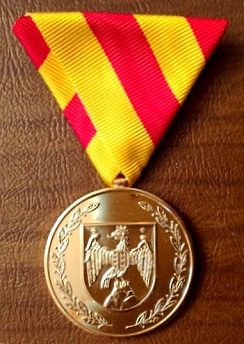 persons
who have accomplished special services for the general welfare through
public or private work or promoted otherwise the status and development of the Province
of Burgenland, and persons who have acquired merit in subjects that are in
execution of a provincial matter." persons
who have accomplished special services for the general welfare through
public or private work or promoted otherwise the status and development of the Province
of Burgenland, and persons who have acquired merit in subjects that are in
execution of a provincial matter." These awards add to the distinguished list of BB staff members previously honored by the Burgenland government: Gerry Berghold (Ehrenzeichen), Bob Strauch (Verdienstkreuz / Cross of Merit), Tom Glatz (Goldene Medaille), Anna Kresh (Goldene Medaille), and Frank Teklits (Verdienstkreuz). 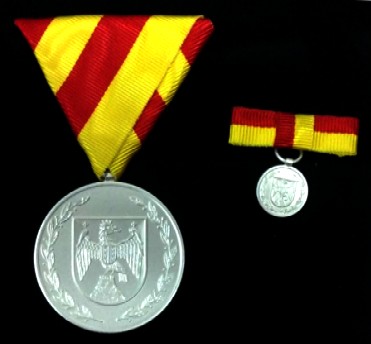 In
addition, the Burgenländische Gemeinschaft chose to make me a lifetime honorary member (Ehrenmitglied)
of their association, complete with an elegant certificate announcing that honor. These honors
by the BG and the government were truly appreciated by all who received them, even though they
were not the reason we do this work... but a little praise never hurts! In
addition, the Burgenländische Gemeinschaft chose to make me a lifetime honorary member (Ehrenmitglied)
of their association, complete with an elegant certificate announcing that honor. These honors
by the BG and the government were truly appreciated by all who received them, even though they
were not the reason we do this work... but a little praise never hurts!Late Thursday morning, the BB staff met over a 3-hour brunch to discuss issues of interest to the BB and to share some time together. While we probably could have talked longer, both our significant others and the restaurant staff were giving us a gentle evil eye... so we moved on! 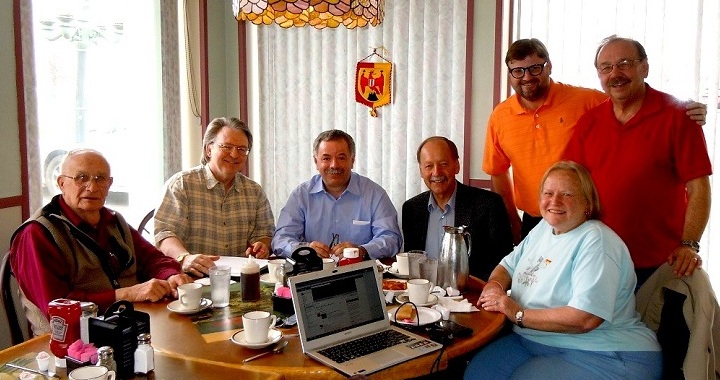 2012 BB Staff Meeting: (l-r) Frank Tantsits, Tom Steichen, Klaus Gerger, Fritz Königshofer, John Lavendoski, Margaret Kaiser and Frank Paukowits. On Thursday evening, we were invited to the Coplay Sängerbund to celebrate the 95th anniversary of the club and the 20th anniversary of the Hianz'nchor. The evening was kicked off by a welcome from Coplay mayor Joseph Bundra and then a light dinner followed by Burgenland strudels, kipfels, cakes and other goodies (yum!), thanks to the ladies of the club. 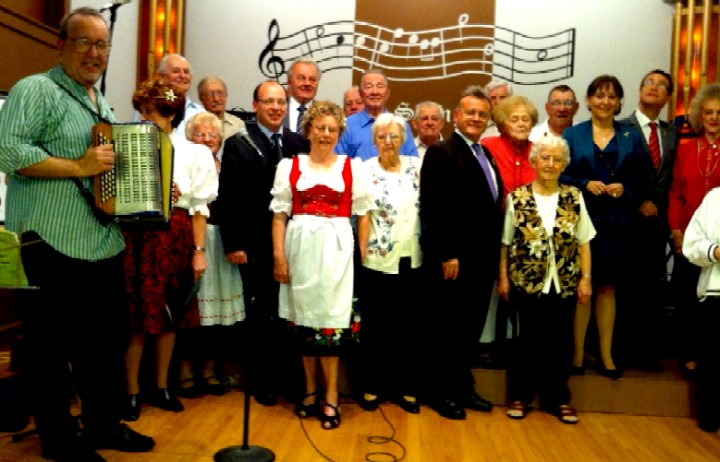 Bob Strauch (near left) and the Hianz'schor, joined by governor Niessl (middle right), delegation members Dr. Peter Rezar, Mag. Michaela Resetar (on right… Peter looking up, Michaela in dark blue), Andreas Liegenfeld and Dr. Walter Dujmovits (middle left, Andreas in dark suit, Walter behind him). The only BB staff member involved this evening was Bob Strauch, as director and accompanist for the Hianz'nchor.  After
addresses by Governor Niessl and State Councilor Michaela Resetar, Bob & the Hianz'nchor
treated us to some rousing Burgenländische songs, which later drew a number from the
delegation on stage to participate. An exchange of gifts and mementos followed, including some
Burgenland 90th Anniversary cufflinks and tie clips for BB staffers, as well as recognition by
the delegation of the Hianz'nchor's 20th anniversary. After
addresses by Governor Niessl and State Councilor Michaela Resetar, Bob & the Hianz'nchor
treated us to some rousing Burgenländische songs, which later drew a number from the
delegation on stage to participate. An exchange of gifts and mementos followed, including some
Burgenland 90th Anniversary cufflinks and tie clips for BB staffers, as well as recognition by
the delegation of the Hianz'nchor's 20th anniversary. Accordionists Joe Weber and Emil Schanta took the stage next and kept the evening going with more ethnic music. Throughout the evening, pitchers of beer appeared on our table... yet soon our glasses were empty again. Not all of us were moved to song but, as the picture to the right shows, Frank Paukowits and Governor Niessl were not shy, serenading and toasting the room. It was an enjoyable visit for all involved but was over too soon. On Friday the delegation moved on to New York, our BB staff found their way home, and Bob Strauch commented, when later asked about upcoming Lehigh Valley ethnic events, "I think we had enough action here last week to last us a while." Maybe he is right, after all, the delegation visits only every five years! |
|
4) ANOTHER LINK REMOVED... I debated whether to write this article... it is about the death, and life, of my mother... but here it is...  My
mother, Clara Schaefer Steichen, 1923-2012, died at 2 am on March 26, on the very day I
was traveling to Minnesota to say my final goodbye... it is a goodbye now left unsaid forever. My
mother, Clara Schaefer Steichen, 1923-2012, died at 2 am on March 26, on the very day I
was traveling to Minnesota to say my final goodbye... it is a goodbye now left unsaid forever.
We knew she was dying, the only question was when. An undiagnosed stomach cancer, which had already spread into her kidneys and lungs before blocking her intestines, caused her to be taken to the hospital. Although the blockage could be removed, her heart was weak, making surgery a great risk, and the removal of the blockage would only have extended her life at most a month, so she chose to let it go untreated; she survived less than a week after making her decision. While we miss her dearly, we also know her choice spared her more pain. Mother's health took a turn for the worse 10 months ago when a stroke landed her in a nursing home. Her lower body no longer responded to her and she required more assistance than we could give her in her home. Although she seldom had a day where at least one of her nine children did not visit, it was still a bleak existence with no hope of improvement. Still, only once, right after Christmas, did she have a bout of depression. But, at eighty-eight and a half and with a terminal cancer, she was ready to meet her God. 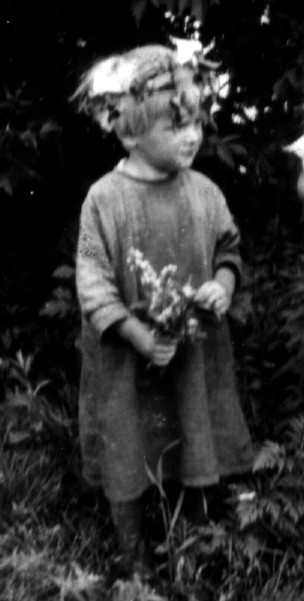 My
mother was my link to Burgenland through her mother. Mom was born in central Minnesota in
1923, to Barbara Weiss and John Schaefer (John was of Westfalen Germany descent), and raised
in an ethnically German area. While there were a few Austrian (and even Burgenland) families
in the area, it was mostly populated by emigrants from Germany and Luxembourg. Mom was never
given a middle name... so she was Clara, 'just Clara'. Back when I started my genealogical
quest, Mother had only a faint recollection that there might have been a Hungarian connection
through her mother... she knew her mother's people spoke "funny" German but wasn't quite sure
why. My
mother was my link to Burgenland through her mother. Mom was born in central Minnesota in
1923, to Barbara Weiss and John Schaefer (John was of Westfalen Germany descent), and raised
in an ethnically German area. While there were a few Austrian (and even Burgenland) families
in the area, it was mostly populated by emigrants from Germany and Luxembourg. Mom was never
given a middle name... so she was Clara, 'just Clara'. Back when I started my genealogical
quest, Mother had only a faint recollection that there might have been a Hungarian connection
through her mother... she knew her mother's people spoke "funny" German but wasn't quite sure
why.Her mother, Barbara, was also born in central Minnesota, in 1891, most likely within 10 miles of my mother's birth location (but I have yet to prove that via civil or church records... I do know the Minnesota location where three younger siblings were born in 1893-1897—and have strong reasons to believe Barbara was born there also—but no documentation!). Barbara was the daughter of Joseph Weiss (born 1863 in Féltorony/Halbturn; my great-grandfather) and Theresia Halbauer (born 1863 in Valla/Wallern; my great-grandmother). Joseph emigrated from West Hungary / Burgenland in 1887 and Theresia and her three Burgenland-born children followed in 1889. The picture below shows the Joseph Weiss family in 1894, accompanied by Theresia's brother, John Halbauer (far left). Barbara is the quite young lady in the lower center. All Halbauer family members who survived into adulthood eventually followed Joseph and Theresia to Minnesota, with the exception of Theresia's brother Felix, who died in early adulthood; however, Felix's wife and young children came to Minnesota after his death. Even Theresia's twice-widowed mother, Maria (Trautner) Halbauer / Bauer (below left; my great-great-grandmother), came to Minnesota after son Felix's death. Georg Weiss, the only sibling of Joseph who survived to adulthood, lived out his life in West Hungary. 
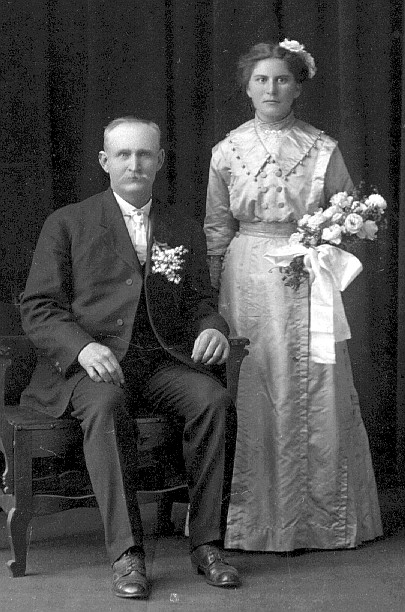
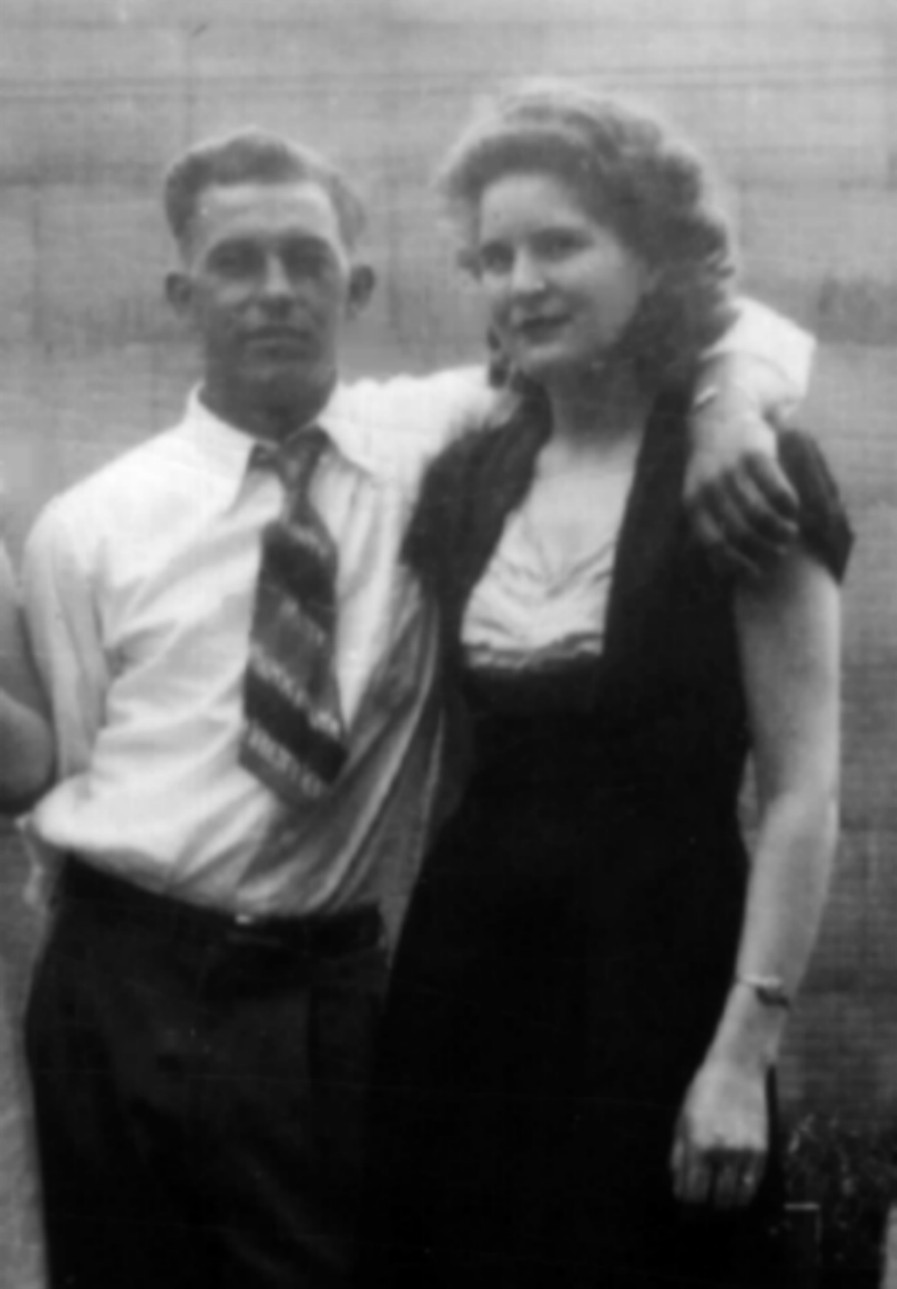 Maria (Trautner) Halbauer / Bauer — John Schaefer & Barbara Weiss — Bernard Steichen & Clara Schaefer Barbara Weiss, conceived shortly after her parents reunited in Minnesota, married John Schaefer in 1912 (shown middle above; my maternal grandparents). John was 44 and she was just 21. When John died at age 70 in 1938, my mother was still only 14 years old, with two younger sisters yet to be raised. By necessity, Mother soon dropped out of high school in order to take a fulltime job to help support her fatherless family. Then Bernie Steichen came into her life (pictured above right; my parents) and marriage in 1949 seemed more important than schooling... and then a succession of her own children ended all thoughts of more education. She always regretted being unable to complete high school (or more), as she was a bright and capable student. As a result, she took great pride in the educational accomplishments of her own children and was a voracious reader of histories, the classics, and even encyclopedias; a life-long special challenge was competing against contestants on knowledge-based TV game shows—and she seldom lost! Mother raised nine children (I was her second) with love, tolerance and perseverance. We were a rowdy bunch of kids, who occasionally tried her soul, but she guided us to adulthood with her sanity intact, having passed on her principles of commitment and proper behavior. A point of pride for her was that, of the seven of us who married, none have divorced. 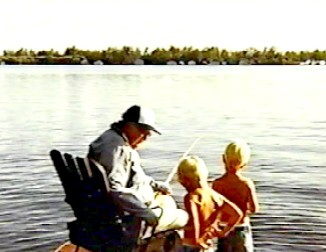 When
all of us were gone, grandchildren became her joy... and also fishing! (especially if she
could go fishing with her grandchildren). She didn't care if she caught any—but she always
did, even when all her fishing companions were coming up empty. When
all of us were gone, grandchildren became her joy... and also fishing! (especially if she
could go fishing with her grandchildren). She didn't care if she caught any—but she always
did, even when all her fishing companions were coming up empty.However, I was able to pull her away from fishing to be my partner in genealogy. Mother was my boon companion during my early exploration of family history (Dad never understood why we cared about "the past," it was the future that mattered, he claimed). Regardless, Mother spent many hours beside me at the Stearns History Museum (in St. Cloud, MN) going through old records and uncovering the facts and mysteries hidden in the family tree. She wasn't much interested in such mundane things like "lunch" if the research center was still open, and she freely shared her discoveries with other researchers and the museum staff, doing it with such joy that they didn't seem to mind the interruptions. She walked beside me as we visited cemeteries and old family sites, telling tales that I never could have discovered alone, and she was always ready to visit a cousin if that is where our research took us. Even when I was far away in North Carolina, an email or phone call from me describing my latest great “find” brightened her day (and often prompted a remark like "Oh! I knew that!" ...and then she would fill in the detail that a paper record could never give). 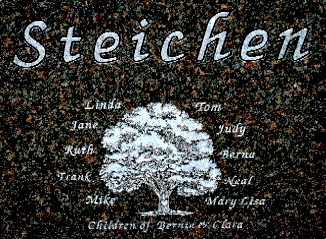 Interestingly,
one of the key features of the family gravestone Mom picked out after my father died in 2005
was an etching, on the back of the stone, of a family tree, with each of her children's names
surrounding the tree. It seems I did pass the genealogical bug on to Mom! ...but she is the
one who chose to take it with her into eternity. After her stroke this past year, I would take
my laptop along on my visits, again sharing new finds, but also testing her mental acuity by
showing family pictures... she knew them better than me! (She also unmercifully whipped me in
cards, showing that skill hadn't degraded either!) Interestingly,
one of the key features of the family gravestone Mom picked out after my father died in 2005
was an etching, on the back of the stone, of a family tree, with each of her children's names
surrounding the tree. It seems I did pass the genealogical bug on to Mom! ...but she is the
one who chose to take it with her into eternity. After her stroke this past year, I would take
my laptop along on my visits, again sharing new finds, but also testing her mental acuity by
showing family pictures... she knew them better than me! (She also unmercifully whipped me in
cards, showing that skill hadn't degraded either!)But now she is gone... and I've lost an important link in my chain back to Burgenland ...such a strong link! I'll miss you Mom. (And Dad, if you are peeking in, you are not forgotten... but this story is about Mom. The story of your Luxembourg roots is also an important part of my family history but it just doesn't fit in this Newsletter... so, for now, just welcome Mom for me!) I'll leave you, my readers, with the chorus of a song I like... the words are by Tim Bays... but its philosophy was vintage Mother:
So, love you, Mom, with all my heart! |
|
5) "DIE AMERIKA-WANDERUNG DER BURGENLÄNDER" THIRD EDITION As mention in Article 3 above, Hofrat Dr. Walter Dujmovits, former educator and longtime president of the Burgenländische Gemeinschaft, has announced the third edition of his book, "Die Amerika-Wanderung der Burgenländer," and plans to issue an English version of it in 2012. The book, based on his University of Vienna dissertation, was originally published in 1975, with a second edition issued in 1992; it is still considered the leading publication about emigration of Burgenländers to America. In the forward of the new edition, Dr. Dujmovits comments about the changing nature of Burgenland emigration and how it is the children and grandchildren—and the Burgenland Bunch—that now keep the memory alive. In recognition of the decline of Burgenland-related, brick and mortar, social-support societies in America, I was asked to provide information about the Burgenland Bunch and other internet-based organizations. Below is what I provided... Internet Formal Burgenland-based ethnic societies in the United States continue to disappear as their membership ages and their youth are Americanized. However, the basic concept of such societies is not totally gone... but it has changed. The Burgenland Bunch, founded in 1997, uses the internet to provide some of the social and relational benefits of the earlier societies and to preserve and pass along the culture and traditions of our heritage. Its emphasis, however, is genealogy and history, not social support. There are two other internet-related organizations that provide some limited social benefits, “Austrian Club - Österreichischer Stammtisch” and “www.usaustrians.com” but, again, neither group provides either a club facility or financial benefits and neither is Burgenland specific. The Burgenland Bunch The Burgenland Bunch (BB) is an international, internet-based, volunteer organization dedicated to the genealogy and history of Burgenland. It was founded in January 1997, when Gerald Berghold (Winchester, VA, USA; 1930-2008), grandson of four emigrant Burgenländers, published the first issue of an e-mail newsletter, "The Burgenland Bunch News," which he sent to a small group of correspondents interested in Burgenland. A website followed a few months later to provide a depository for their shared information. These first steps evolved rapidly into the Burgenland Bunch, an organization formed to foster preservation of Burgenland ethnic heritage and memory of the Burgenland Auswanderung. Gerry once defined the “Bunch” as “a homogeneous grouping—in this case, descendants of Burgenland immigrants, loosely connected by a website and a newsletter.” From an initial mailing to just 12 correspondents, its monthly English-language newsletter now reaches over 2000 recipients residing in every US state and many countries of the world. From 1997 through 2005, the newsletter was formatted as text-only and distributed as e-mail, with the first 88 editions being issued bi-weekly. From 2006 into 2008, it was simultaneously formatted and distributed both as an e-mail and an online version; the online configuration adding graphics, color and better formatting. Since then, it is distributed solely as an online publication, with only an e-mail notice sent to members to announce its availability. Gerry Berghold edited and published the initial 176 editions. Hannes Graf (Vienna, Austria) became Editor in September 2008, publishing 24 editions. Tom Steichen (Winston-Salem, NC, USA) accepted the roll of Editor in August 2010. A joint US and Austrian staff of 18 volunteers supports this ever-growing organization and its website, www.the-burgenland-bunch.org, provides input to the newsletter, and/or provides answers and advice. The BB is currently led by President Thomas Steichen and Vice President Klaus Gerger (Vienna, Austria). In addition to Tom and Klaus, Hannes Graf (Vienna, Austria), Alan Varga (Bloomingdale, IL, USA) and Frank Paukowits (Flushing, NY, USA) are part of the Managing Staff of the BB website. Tom handles the Home, Surnames and Villages pages and, as noted above, is the Editor of the monthly Newsletter, Klaus handles Austrian Contacts, Maps, Houselists and Research, Hannes handles the Membership pages, Alan handles the URL/Links page and Frank is in charge of the Burgenländers Honored and Remembered (BH&R) part of the BB website. BH&R was created in 2003 and became affiliated with the BB in 2008. There are also 13 Contributing Editors who provide articles, research services and expertise on specific areas. Of this current group of 18 volunteers, only three were on Gerry’s initial Staff of 11 as published at the end of 1998. One of the goals established at the founding of the Burgenland Bunch was to develop an archive of English-language articles about Burgenland history and culture. The newsletter (and its archives) was the medium by which this goal was to be accomplished. As of the 100th edition in October of 2001, founder Gerry Berghold noted that there had been "some 1,300 articles in all" of which some 400 were of "major interest" (i.e., important to research). For the 200th edition in June of 2010, then-Editor Tom Steichen estimated that “we are around 2,500 articles now and have substantially increased the count of research-quality articles. We continue to be the largest source for English-language information about Burgenland, a claim that made Gerry Berghold proud and one that pleases me also.” The BB website, which is visited by about 4,000 people each month, documents nearly 7,000 Burgenland emigrant family names and holds extensive historical and genealogical resources. It is the archive for the newsletter, the host for the Members and Surnames databases, a repository for maps and cross-references of Burgenland villages through their Hungarian, German, and Croatian names, a source for locations of parishes and municipal offices and for available church and civil records, and a provider of links to many other websites that relate to Burgenland. Its affiliated sub-site, BH&R, documents and honors over 11,000 Burgenland emigrants who are buried in the United States. As an organization, the Burgenland Bunch identifies and addresses areas of original research which shed light on the lives of Burgenland ancestors. It provides English-language translations of here-to-fore untranslated material. It offers membership to descendants and lists and archives their family data, maintaining it on the internet website. The BB also links researchers through an e-mail network, engages actively in uncovering records available for genealogical research, and provides assistance in reading German and Hungarian script and deciphering archaic terms. All of this is done with the goal of expanding Burgenland family history, sustaining the memory of immigrant ancestors and retaining links with the homeland. Founder Gerry Berghold published numerous articles in newsletters and magazines around the world. He was honored for his efforts on behalf of Burgenland history, receiving the Ehrenzeichen des Landes Burgenland (Honor Award of the State of Burgenland) from the Burgenland Parliament, presented in person by Governor Niessl, in appreciation of Gerry's efforts in fostering the advancement of Burgenland family history and culture; the Burgenländische Gemeinschaft also recognized him as an honored member. On August 29, 2008, after five years of battling cancer, Gerry passed away in his home in Winchester, VA, having officially retired from the Burgenland Bunch less than a month before. In honor of his life and commitment to Burgenland history, the Burgenland Bunch website is dedicated to his memory. USAustrians.com Another internet-only organization is http://www.usaustrians.com, which defines itself as "the free social website for all Austrian Companies and Organizations in the USA who want to show who they are and what they do." It reaches out to recent emigrants and provides support structures for Austrians in the United States. Austrian Club - Österreichischer Stammtisch A newer, social-based organization is the "Austrian Club - Österreichischer Stammtisch," of Richmond, VA. In their words, their purpose is "to bring Austrians in the Mid-Atlantic area together. Our goals are to socialize, speak German and to have lots of fun!" Their website is at http://www.austria-richmond.com. |
|
6) ROBERT LOERZEL'S MISCHENDORF GENEALOGY WEBSITE Every so often, I run an article about one of our member's Burgenland-related genealogical websites. Articles like this are part of one of the many occasional series, as I call them, that I return to when the spirit moves me. Generally I go to the list of member websites on our Links page (at http://www.the-burgenland-bunch.org/Links/links.htm#membpgs) and pick one to write about. In this case, though, I stumbled across Robert's site when I was searching the web for something else. Only later did I notice that we had Robert's site in our list. I will note that the link on our Links page is actually to Robert's main website; the Burgenland genealogical portion is two links down from his parent site (see sub-site http://www.robertloerzel.com/genealogy/Burgenland/Burgenland.htm). 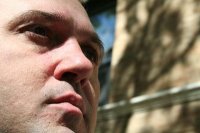 Robert
lists himself as a "Chicago author, freelance journalist and photographer" and his main site
encompasses all these interests. However, he also has key links to his art, music and
genealogy, as well as to some short-story fiction. Robert
lists himself as a "Chicago author, freelance journalist and photographer" and his main site
encompasses all these interests. However, he also has key links to his art, music and
genealogy, as well as to some short-story fiction. Among these pages, it appears that the genealogical portion is the oldest and least updated, with almost everything in the Burgenland portion being from about 2000. Even the link to the Burgenland Bunch refers to the original BB homepage (www.spacestar.com/users/hapander/burgen.html) that Hap Anderson developed (and from which we moved in early 2006). Nonetheless, it still holds some material that should be of interest to some of our members. Robert says on his website that "Many of my ancestors came from the village of Mischendorf in southern Burgenland, Austria, and the surrounding towns. The names on my family tree from this area include Walter, Kassanits, Knarr, Polzer, Bilovits, Graf, Futsits, Unger, Schuh, Reschetarits, Sulyok, Visler, Schendl and Haas. This Web page presents some of the historical information I have compiled about the area around Mischendorf, as well as photos." Indeed, it is the history and photos that I suspect could prove most useful. The "History" is presented in both German and English, the German version being copied from a display at the Mischendorf Gemeindezentrum (municipal building) and the English version being a translation provided by Robert with the help of Albert Schuch. The five photos in the "Historical Photos" section span 1905 to the 1950s. The most interesting are two photos that, according to Robert, "appear to show a Blochziehen (trunk pulling) ceremony, which is held when no marriage takes place in a village during the year. A 'wooden bride' is pulled through the streets during the carnival season (Fasching) and one of the village's unmarried men acts as the 'groom.'" The eleven photos in the "Recent Photos" section (recent, circa June 2000) give a good impression of the town and area during that period. 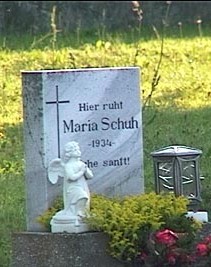 The
"Cemeteries" section may be most useful of all, although it would be titled better as
"Cemeteries and War Monuments." Apparently, Robert photographed many headstones and monuments
in the Mischendorf area. Included in these are headstones from cemeteries in Mischendorf,
Kohfidisch, Kotezicken and Bachselten as well as names on the War Monuments in these same
towns plus Kirchfidisch and Rohrbach an der Teich. He also made lists of the names, along with
dates and other inscriptions from the stones and cemeteries. He says, "The lists for
Mischendorf and the various war monuments include every name. The lists for the other towns
are selective; they include only headstones with surnames on my family tree." Although he
does not include, on his website, a photo of every headstone in his lists, he says "If you
are interested in receiving a photograph of a particular headstone, contact me and I will send
you one by e-mail." The
"Cemeteries" section may be most useful of all, although it would be titled better as
"Cemeteries and War Monuments." Apparently, Robert photographed many headstones and monuments
in the Mischendorf area. Included in these are headstones from cemeteries in Mischendorf,
Kohfidisch, Kotezicken and Bachselten as well as names on the War Monuments in these same
towns plus Kirchfidisch and Rohrbach an der Teich. He also made lists of the names, along with
dates and other inscriptions from the stones and cemeteries. He says, "The lists for
Mischendorf and the various war monuments include every name. The lists for the other towns
are selective; they include only headstones with surnames on my family tree." Although he
does not include, on his website, a photo of every headstone in his lists, he says "If you
are interested in receiving a photograph of a particular headstone, contact me and I will send
you one by e-mail."Among the remaining links is one with an 1880s topographical map of the area; all other links are either broken or their content was never completed. Despite these problems, there is useful material. However, I hope Robert finds time some day to fix the issues and expand his effort. |
|
7) LDS FILMS SECTION UPDATE: A FOLLOW-UP Last month, I reported on the update of the BB's LDS Films Section. Subsequently, a discussion broke out that provided a few bits of interesting information on Jewish and Lutheran records. I provide the discussion thread below... Margaret Kaiser wrote: I sent a response to Chantal Pernecker. In the process I looked on our BB Village Lists and saw the RC [Roman Catholic] and Lutheran records [for Kittsee] are listed as being in Deutsch Jahrndorf. I looked at Albert's List, which refers only to Jewish records for Kittsee. www.familysearch.org has films listed for Kittsee. The numbers for the Kittsee films are different from those for Deutsch Jahrndorf. I don't know where the info on the Village List may have come from, but it appears not to be accurate. I don't see a location anywhere, other than the Village Lists, for Lutheran/Evangelical records for these locations. The Familysearch catalog does not list evangelical records for either of these places. It is possible that this was not an evangelical area. I replied: The Deutsch Jahrndorf (DJ) reference in Villages for Kittsee was entered before my time… but Ed Tantsits also had DJ as the LU [Lutheran] parish in his LDS list, so I read that to mean DJ was the correct LU parish but LDS did not film those records. The BB LDS pages have the RC, JR [Jewish Records] and GV [Government/Civil] film #’s listed. I updated the BB Village page to be consistent with this. By the way, Albert used the term “mosaic”, abbreviated “mo” in his list. This code is used for Kittsee. Does anyone know what Albert meant by this term? Fritz Königshofer replied: In the Dvorzsák gazetteer of 1877, the entry for Kittsee says that Lutherans, if any, had their congregation in Rajka (Ragendorf). When I checked the entry for Deutsch Jahrndorf, I was surprised to find a Lutheran and RC parish. This indeed raises the question why there is no Lutheran parish microfilm listed. Perhaps only the originals exist and are at the parish. Mosaic means Jewish. The word is derived from Moses. I replied: Thanks Fritz, mosaic is obvious when the connection to Moses is made… but I missed it anyway. I got hung up on the possibility that this term indicated an assemblage of small chunks of records of different types, kind of like mosaic artwork. Deutsch Jahrndorf is not the only village we point to as a record holder, whereas LDS shows nothing filmed. http://konyvtar.ksh.hu/digitalizalt_anyagok/helysegnevtar/1873/ shows DJ as having its Lutheran parish in Rajka in 1873 but http://konyvtar.ksh.hu/digitalizalt_anyagok/helysegnevtar/1877/ shows it as its own LU parish in 1877 (as do later gazetteers in this series). Fritz replied: Upon making some checks in the Dvorzsák gazetteer, I think I know why there is no LDS microfilm of the Lutheran records of Kittsee and Deutsch Jahrndorf (and likely other places in Northern Burgenland [Ed: actually, Deutsch Jahrndorf is the only missing congregation; however, Kitsee and Pama Lutherans attended there so their records are missing too]). Since 1826/1827/1828, [Ed: Catholic] parishes had to write duplicates of the vital records and send these on an annual basis to their diocese. For the area of the future Burgenland, the [Ed: Catholic] duplicates went to the dioceses in Szombathely and Győr. When LDS received permission to film the parish and government records of Hungary, it was able to film records of Burgenland, albeit only the duplicate ones. The Austrian churches did not agree to an LDS filming of their records. As far as the Lutheran records are concerned, the equivalent of diocese was the superintendancy. That's where congregations sent their duplicates to. Apparently, there were two [Ed: Lutheran] superintendancies covering Burgenland, namely Dunántul (Transdanubia) and DunánInnen (Cisdanubia). The superintendent for Transdanubia had the seat in Győr, the one for Cisdanubia in Bratislava (Pressburg). LDS was not able to film the church books of Slovakia until the effort that started about 5 years ago. Parishes which belonged to DunánInnen did not have their records filmed by LDS (yet). So, the take-a-ways from this discussion are two-fold: First, that "mosaic" records are Jewish records; Second, that many northern Lutheran records were not filmed by the LDS, as they were not held by the Hungarians. I have updated Albert's List to more clearly
explain the "mosaic" term. In addition, we have the good news that these missing Lutheran
records (those held in Bratislava) are in the queue for filming, though when they will be
available is unknown. |
|
8) HISTORICAL BB NEWSLETTER ARTICLES Editor: This is part of our series designed to recycle interesting articles from the BB Newsletters of 10 years ago. In our April 2002 Newsletter, Gerry Berghold gave good advice concerning the need for caution in accepting the recorded or transcribed names of people and places in the Ellis Island ship manifests. I did find it curious, however, that he used the term "translation" when he clearly meant "transcription" or "recording." But this is the reality of self-edited writing: the Editor is least able to see his own errors! THE BURGENLAND BUNCH NEWS No. 106A April 30, 2002 ELLIS ISLAND BURGENLAND TRANSLATIONS [Ed: TRANSCRIPTIONS] As we search family history records that have been "writ by hand" we enter into a never-never-land of translation [transcription] problems. We must become well versed in the script of some long gone recorder and the geography of our places of origin. Research is becoming easier, as helpful people everywhere digitize some of these records for us, translate and compile typed lists and make them available on the internet. We must, however, always look upon such copies with a jaundiced eye. Where the data isn't obvious, we should revert to the original, translate [transcribe] it ourselves, or get help. A case in point are the Ellis Island (EI) records. Lately, many new BB members are using these records to determine unknown villages of origin. Some of the names are easily recognizable, even if improperly spelled. Others are figments of someone's imagination. Don't misunderstand, I have nothing but the utmost admiration for those intrepid souls who are digitizing these ship manifests, a labor of love. I've searched some of them and the translations [transcriptions] are a real challenge. It would require someone well-versed in a particular geographic area to determine the proper names of some of the towns and villages mentioned... when even the immigrants didn't know how to spell them. Many immigrants furnished the name of the largest nearby city. I also am certain that some of the recorded places of origin where taken from papers carried by the immigrants. These documents quite often carry the name of the place where the documents were issued, the district city or capital, not their actual place of residence. For some time, I tried to find my grandfather Berghold's first entry to the United States. I  knew
he came in 1902, married, had three children, returned to Burgenland, built a new house there
and later again migrated to the US (1912). The second voyage record is easily found, the first
was prey to a host of translator [recorder / transcriber] misspellings. After many attempts, I
found him under the name Barghold. knew
he came in 1902, married, had three children, returned to Burgenland, built a new house there
and later again migrated to the US (1912). The second voyage record is easily found, the first
was prey to a host of translator [recorder / transcriber] misspellings. After many attempts, I
found him under the name Barghold.This may mean that the first search for a misspelling might best be made by substituting vowels in the spelling of the name. A "B" is easy to recognize (sometimes mistaken for a  "P")
and the vowels "a"-"e"-"o" and "u" are often improperly translated [recorded]. I had first
tried various phonetic spellings (another good approach) without success. I finally found a
record for Johan Barghold (should be Johann Berghold), Hungarian, place of residence ...ut
Gothand (should be Szt. Gotthard), date of arrival November 26, 1902, age 25, male,
single, arrived on the Kaiser Wilhelm der Grosse from Bremen, ultimate destination
Allentown (correct spelling). "P")
and the vowels "a"-"e"-"o" and "u" are often improperly translated [recorded]. I had first
tried various phonetic spellings (another good approach) without success. I finally found a
record for Johan Barghold (should be Johann Berghold), Hungarian, place of residence ...ut
Gothand (should be Szt. Gotthard), date of arrival November 26, 1902, age 25, male,
single, arrived on the Kaiser Wilhelm der Grosse from Bremen, ultimate destination
Allentown (correct spelling).No doubt this was my grandfather, everything fits. The ...ut Gothand for Szt. Gotthard was obvious when I checked the original manifest but, if you weren't aware of this place, you'd never translate [transcribe] what was written as such. Szt. Gotthard in 1902 was the district capital (Hungarian - Jaras, German - Bezirk) for Poppendorf, which was the real village of origin for my grandfather. Without my lengthy experience and knowledge of my family's history, I could be left with the idea that the family name was really Barghold and that they came from some unknown Hungarian place called ut Gothand. I could also spend months searching Szt. Gotthard church records for the Barghold family, when they are under the name Berghold in Eltendorf (Lutheran church for Poppendorf). See what I mean? I wonder how many EI record searchers are making that very mistake? It was interesting that the manifest pages before and after this entry were almost completely filled with Hungarians and Hungarian place names—very few of which were spelled correctly. I pity the poor soul who had to translate [transcribe] them and make some sense out of the records, they were probably expert in some unrelated aspect of family history—maybe Hispanic or Asiatic, but not Austro/Hungarian! I've had correspondents take issue with me over my interpretation of the misspellings of village names they have found. After all, they say, it came from an "official" record and must be correct! Even after I point out the obvious, they'd much rather believe what was written. So be it—they face hours of unrewarding research. My grandmother Mühl-Sorger and her mother have perfect EI records, except that their place of residence is shown as Vienna. I know they never lived there and I have their complete itinerary. They stopped in Vienna and changed trains for Antwerp. Some less experienced searcher would now say that Vienna is their place of origin and get lost in the record morass of that great city. My great-aunt Franziska, who arrived one year later, is shown as coming from Nemet Ujaar, Hungary (no such place). This should be Nemetujvar, the Hungarian name for Güssing. My grandfather Sorger is shown as coming from Balazsfoln, Hungary. This is probably Balogunyom, which was the nearest railhead to where he was working at the time. By all means, search those EI records—they are priceless—but don't accept them as gospel without further proof. Data for three out of my four grandparents was in error. At best, they are another clue to your correct family history and a good place to find and buy a picture of their immigration ship to show grandchildren. Obsession with an immigrant's date of arrival in the United States is referred to as the "Mayflower syndrome," but it's a major part of an American family history and the EI records are the place to look. Editor: Having read the above article, I could not help but smile when I read the next article in that 2002 Newsletter; it was a short snippet about the upcoming 2002 Midwest BB Picnic. In it, the stated location for the picnic was "Wabun Park in Minneapolis, Minnesota." I was born in Minnesota and had lived in Minneapolis for a while... but I had never heard of a "Wabun Park." A little investigation revealed that the correct wording should have been "Wabun Picnic Area in Minnehaha Park in Minneapolis, MN." For Minnesotans, Minnehaha Park is rather famous... Wabun? ...pretty much unknown. But I doubt Gerry, given his PA roots, had any idea that this was a reverse-twist on the "claim a bigger city" syndrome he had just spoken of! |
|
9) ETHNIC EVENTS LEHIGH VALLEY, PA (courtesy of Bob Strauch) Friday, May 4, 6 - 9 pm: The Blue Notes in the Clubhouse. $6. Evergreen Club, 415 Hartz Road, Fleetwood, PA. 610-944-7501. Kitchen open 5:30 to 9:00 p.m. Reservations suggested. Friday-Sunday, May 4-6: Tanz in den Mai Weekend! Reading Liederkranz, 143 Spook Lane, Reading, PA. Info: www.readingliederkranz.com. Traditional European and German celebration. Kermit 5 - 7 pm and the Joe Kroboth Band from 7 to 11 p.m. on Friday. Kentucky Derby Party on Saturday... big screen TV for the race... music of Kitty Wise from 7 to 11 p.m. Sunday morning Brunch, 10 am to 2 pm, followed by Stanky and the Coal Miners from 1 to 5 p.m. Open to the Public and Free Admission. Saturday, May 5: Maibaumtanz/May Pole Dance at the Coplay Sängerbund. Entertainment by the Coplay Sängerbund Chorus and the Joe Weber Orchestra. Saturday, May 5: 154th Anniversary Concert of the Lehigh Sängerbund at Egner Memorial Chapel, Muhlenberg College, Allentown. Entertainment by the Lehigh Sängerbund and Reading Liederkranz Choruses. Info: www.lehighsaengerbund.org Sunday, May 13, 12 noon to 3 pm: Mother’s Day Dinner. Reading Liederkranz. Menu includes a choice of Roast Beef or Chicken Cordon Bleu, potato, vegetable, soup, salad bar, dessert bar, roll & butter and coffee & tea. $15. Call for reservations, 610-373-3982. Sunday, May 13: Mother's Day Brunch. Two seatings: 10 a.m. and 12 Noon. Evergreen Club. Reservations suggested. Friday, May 18, 6 - 9 pm: Walt Groller in the Clubhouse. $3. Evergreen Club. Kitchen open 5:30 to 9:00 p.m. Reservations a MUST! Thursday-Monday May 24-28: Sommerfest at Mayfair, Cedar Beach, Allentown. Sponsored by the Lehigh Sängerbund. Info: www.lehighvalleysommerfest.org Friday, May 25, 6 - 9 pm: Joe Kroboth Duo in the Clubhouse. $3. Evergreen Club. Kitchen open 5:30 to 9:00 p.m. LANCASTER, PA First Tuesdays, May 1, 5:30-7:30 pm: All you can eat Buffet. Entertainment by Carl Heidlauf on Piano. ~ Open to the Public ~ $10 ($12 guests). Lancaster Liederkranz, 722 S. Chiques Rd, Manheim, PA. lancasterliederkranz@verizon.net, 717-898-8451. First Friday, May 4, 5:30-7:30 pm: Entertainment by Hans & the Accordian. Lancaster Liederkranz. Saturday, May 12: Maitanz. ~ Open to the Public. Lancaster Liederkranz. Musical Entertainment by Joe Kroboth. Saturday, May 13: Mother's Day Buffet. Lancaster Liederkranz. Entertainment by Carl Heidlauf on Piano. Friday, May 18, 8 pm: Kompass Rose in the Ballroom. Lancaster Liederkranz. NEW BRITAIN, CT Friday, May 4, 7 pm: Heimat Abend. $3. Austrian Donau Club, 545 Arch Street, New Britain, CT, (860) 223-9401. Music by Joe Rogers and his band. Hot food is available from the kitchen. Sunday, May 8, 8 am - Noon: Sonntag Frühstuck. Austrian Donau Club. Come enjoy breakfast. Friday, May 18, 7:30 pm: Heurigan Abend. $3. Austrian Donau Club. Music by Schachtelgebirger Musikanten. Hot food is available from the kitchen. Tuesdays at 7 pm: Men's and Women's Singing Societies meet. Austrian Donau Club. Thursdays at 7 pm: Alpenland Tänzer (Alpine Country Dancers) meet. Austrian Donau Club. ST. LOUIS, MO (early notice, courtesy of Nancy W Thomas) Friday & Saturday, July 13-14: 2012 Missouri State Genealogical Association Conference, to be held in Columbia, MO, at the Stoney Creek Inn. Keynote Speakers are Pam Boyer Sayre, CG, CGL and Rick Sayre, CG, genealogy experts who will be presenting lectures on various land records and maps. Supporting speakers include Patricia Walls Stamm, CG, CGL, Pamela Stone Eagleson, CG, Beth Foulke and Carole Goggin. Here are pdf copies of the conference brochure and poster; also see website www.mosga.org for more information or contact Nancy W Thomas, Conference Chairman, NancyThomas@Centurytel.net, 573-443-6052. ST. PAUL, MN (courtesy of Kathy Middendorf) Sunday, May 20, 12:30 pm: Upper Midwest BB meeting, German American Institute, 301 Summit Ave, St. Paul, MN. |
|
10) BURGENLAND EMIGRANT OBITUARIES (courtesy of Bob Strauch) Katharine Sendek  Katharine
Sendek, age 85, of Clinton Township, Michigan, died April 1, 2012. Born August 1, 1926 in
Sopronbánfalva (Wandorf), Hungary. Katharine
Sendek, age 85, of Clinton Township, Michigan, died April 1, 2012. Born August 1, 1926 in
Sopronbánfalva (Wandorf), Hungary.Beloved wife of the late Rudolf.
Loving mother of Emily Sendek Oehlberg, Arnold Sendek and Roswitha Slone. Dearest grandmother
of Christina, Katherine and Kelly. |
|
END OF NEWSLETTER |
|
NOTICE (Terms and Conditions): The Burgenland Bunch (BB) was formed and exists to assist Burgenland descendants in their research into their heritage and, toward that end, reserves the right to use any communication you have with us (email, letter, phone conversation, etc.) as part of our information exchange and educational research efforts. • If you do not want your communication to be used for this purpose, indicate that it is "confidential" and we will abide by that request. • Correspondents who communicate with the BB without requesting confidentiality retain their copyright but give a non-exclusive license to the BB allowing us to forward to BB members, publish in our monthly newsletter or on our website, and/or subsequently and permanently archive all or parts of such communications. The Burgenland Bunch homepage (website) can be found at: http://www.the-burgenland-bunch.org/ Burgenland Bunch Newsletter, copyright © 2012 by The Burgenland Bunch All rights reserved. Permission to copy excerpts granted if credit is provided. |
 News
News